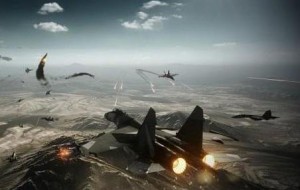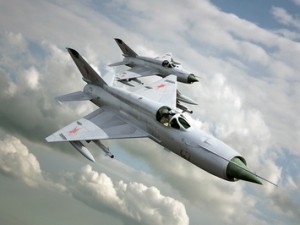Blown Slick Series #8 (Part 2/3)
Continuing from Part 1 – drilling down
To make reasonable decisions in regard to analysis of future airpower, and also how implementation of emerging technical and derivative tactical concepts plays into the application of airpower, one must certainly have some understanding of these elements:
- current potential crisis and warfare environments (subjects of future articles)
- overall theories of airpower (some discussion in this series)
- necessity for a truly joint, even integrated, approach to warfare that has been provided through experience (to be discussed in future articles but can be particularly seen in the AirSea Battle concept and in regard to potential problems related to operations in the South China Sea)
Historical context also must guide airpower’s future evaluation and application. Quoting from Part 1:
Airpower is all about power projection and mobility. It is the theoretical and eventual conceptual application that comprises the application of military strategy and strategic theory to the realm of actual aerial warfare via strike warfare tactics, techniques and procedures.
And so our background on airpower moves to the historical context of airpower application in regard to power projection, and strike warfare.
Application of Airpower (Something Old)
Power projection is a term used in to intimidate other nations and implement policy by means of force, or the threat thereof, in an area distant from its own territory. StrikeWarfare is the use of tactical aircraft and/or cruise missiles against land targets in an offensive power projection role and in combination with other expeditionary forces. Current practice primarily employs use of precision guided weapons. It includes attack on both key enemy infrastructure/command and control elements and also support of tactical objectives for ground combat units.As a reference for discussion of multi-role fifth generation strike fighters and how they might impact or change future airpower here are the traditional Strike Warfare or Fast Mover Air Combat Missions:
- Basic tactical aircraft roles and missions
- Air-to-air
- Air-to-surface to include both land attack and ship attack
- Intelligence, Surveillance and Reconnaissance (ISR)
- Electronic Attack
- Coordinated Strike
- Reduce enemy’s war-making capacity by destroying specified targets at known locations often inland and heavily defended. Examples: refineries, power plants, oil storage, factories, airfields, troop concentrations, HQs, terrorist training camps, command and control centers
- Interdiction
- Primary – Destroy targets to deny access to areas or movement of resources. Examples: bridges, railroads, roads
- Secondary- attack targets of opportunity
- Armed Reconnaissance
- Patrol area and destroy targets of opportunity
- Secondary: attack fixed targets if no targets of opportunity present themselves
- Close Air Support (CAS)
- Support ground forces in direct contact with enemy forces
- Harass, neutralize, or destroy enemy ground forces
- Requires detailed communication and coordination
- Called in by spotters on the ground or forward air controllers
- Suppression of Enemy Air Defenses (SEAD)
- neutralize enemy anti-aircraft abilities to allow general air superiority over a target area by destroying air defense weaponry or enemy radar (therefore blinding anti-aircraft weapons)
Despite technology advances and changes in varying characteristics of warfare over time, the above remain as “what airplanes and pilots do” in air warfare. Since the airplane was first used in warfare, and certainly during the Cold War, some U.S. aircraft focused on a single mission (air-to-air, the F-104 and F-8; or air-to-ground, A-4, A-7, A-6, and A-10), but other aircraft were designed or modified to be at least somewhat reasonably accomplished in more than single missions and were thus dubbed “multi-mission” aircraft (the F-4, F-111, F-15C/F-15E, F-16, and F/A-18). A good example is the relationship of F-4 Phantom II and MiG-21 Fishbed
Story: The Phantom vs the Fishbed
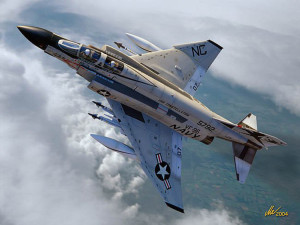
The Navy bought the F-4 Phantom for fleet defense and fighter escort, but routinely armed it with bombs for major Alpha Strikes into North Vietnam. The Air Force intended the a/c as multi-role from the beginning. But interestingly enough a 1965 early war evaluation of Air Force air-ground warfare – the Graham Report – recognized that aircrew were over tasked and lacked proper training for the multitude of missions. From a one of the previously recommended books – The Air Force Way of War: U.S. Tactics and Training after Vietnam, by Brian Laslie on evolution of the Red Flag training concept after Vietnam:
Throughout the Vietnam War, Air Force officers developed new ways of employing the aircraft they flew. Many pilots, tasked to accomplish many types of missions, could not become proficient in any of them. Aircraft designed for a singular purpose (air-to-air intercepts, nuclear delivery, or deep interdiction) and their crews performed air-to-air missions one day, only to be sent against ground targets the next. One squadron might perform an Iron Hand mission to protect a strike package and the next day be the strike package. Fighter pilots in many units became jacks of many trades and masters of none. Tactical Air Command recognized the need for pilots to specialize in one mission set…
One answer was creation of “designed operational capability” statements, called DOC statements for short, which allowed a fighter squadron to focus on one primary mission. DOC statements detailed the primary and secondary mission a fighter squadron was capable of accomplishing and thus allowed more senior planners to easily task squadrons for particular missions. By 1972 you could tell the primary mission of an F-4 squadron by its base in Thailand. For example the air-air mission was focused out of Udorn and Ubon, home of the 8th Tac Fighter Wing was lead for precision-guided bombing.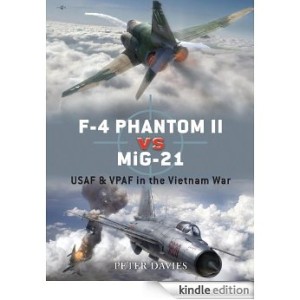
The Soviets had similar design philosophy and some of their very successful MiGs and Sukhois were air-to-air fighters while others specialized in ground attack or were multi-mission. The great rivalry between the US and USSR was an action/ reaction cycle of design, test, build, fight, modernize, and export that lasted for more than four decades.
One example of this cycle is demonstrated by the evolution of MiG-21, which evolved to
become a more capable performance fighter aircraft than the F-4. The MiG-21J achieved higher maneuverability and top-end speed even though the F-4B started as a superior aircraft when compared to earlier MiG-21 designs. More than 5,000 F-4 Phantom IIs were built for U.S. and allied air forces, and the Soviets -exporting the 21 to 60+ countries – diligently worked to take away the F-4’s advantage in thrust to weight. They were finally successful with the MiG-21J.
But it must be noted, while the MiG-21 vs. the F-4 is probably the most robust example of air superiority competition both in design, sales and actual confrontation of the Cold War, the MiGs were “point defense” fighters – operations intended close to their airfields. Aero design characteristics for this type fighter has some significant difference for an aircraft like the F-4 which was required for battlegroup defense, strike escort and Combat Air Patrol, while also called on for pure attack missions.
Beliefs ( and some possible fallacies)
As noted previously , since the time airplanes were first employed in warfare, there have been many rules/assumptions/lessons learned, some good, others proven outright wrong, and some still staking their ground. Theories of airpower and particularly its failures(?) remain in contention.
- The bomber will always get through
- Dog-fighting is history, all air-air will use radars and missiles in beyond visual range engagements
- Conventional warfare as we know it is over, the atomic bomb made strategic airpower the major player in any future war.
- War can be won from the air, without application of land power
- All aspects of air combat will leverage sophisticated computer technology so as to carry out all missions at extended range with a very minimum number of a/c types
- Aircraft carriers are dinosaurs
- Special mission focus a/c like the A-10 are no longer necessary
- We no longer need to risk fighter/attack pilot lives in combat, unmanned vehicles define the next method for air warfare
- Maybe others?
There is no intent now to get into discussion of these beliefs either as valid, somewhat valid or as out and out fallacies, but given these as a starter list, future offerings will take a shot at their intersection with 5th generation based airpower. Just to reflect back on the previous posts on methodology or metrics, give thought to how then a triangle of analysis could be created by taking these items, intersecting with F-35 supposed capability and then adding/comparing with a Middle East ISIS type fight or an A2AD type battle in and around the South China Sea?
From Colin Gray’s Bonfire of the Fallacies ( a previously listed reference) the following is worth considering:
…It may be useful to contextualize my arguments in this article (Bonfires) by offering the reminder that it has been unknown in modern times until now for a state to be militarily dominant in all geographies. The United States cannot always translate this dominance into decisively favorable strategic effect for true political victory, but the facts of the current US superiority are both readily grasped and quite politically appalling and unacceptable to the country’s major state rivals. Hopes to the contrary are almost certain to be revealed by future events to be just that, only hopes.
And what about theory (and some necessary bonfires!)
To continue with Gray:
To understand airpower, most especially American airpower, is a task imbued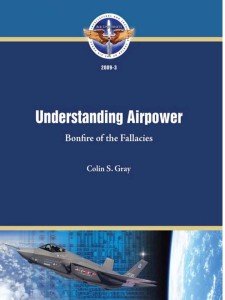 with high significance for national and international security. But, this task is harassed and frequently frustrated by both unsound history and incompetent theorizing. The problem is that those who debate airpower typically seek the history that they can use to advantage, not the history that strives honestly to be true. As for the theory of airpower, it never did take off safely; it continues to fly in contested skies or to taxi indecisively on the runway. No single short study can aspire to correct for 90 years of poor history and shoddy theory, but it can at least make a start…
with high significance for national and international security. But, this task is harassed and frequently frustrated by both unsound history and incompetent theorizing. The problem is that those who debate airpower typically seek the history that they can use to advantage, not the history that strives honestly to be true. As for the theory of airpower, it never did take off safely; it continues to fly in contested skies or to taxi indecisively on the runway. No single short study can aspire to correct for 90 years of poor history and shoddy theory, but it can at least make a start…
… The problems are no longer with a technically flawed military instrument, but rather with the nature of warfare as a duel. Uncooperative enemies have been sufficiently disobliging as to devise tactics intended to deny US air-power the targets it could certainly destroy were it able to locate them reliably. The potential perfection of American airpower, certainly as a kinetic tool for dealing out firepower, must remain only potential, albeit excellent, because its enemies will be motivated, and to some degree able, to find ways to offset the prospectively conclusive US military advantage in the air.
Not infrequently, though certainly not invariably, a country is obliged to fight with a basket of air and air-related technologies that are either more or less technically inadequate for their tasks, or that express what proves by events to be the expression of faulty technical choices. This last point does not always, probably usually, refer to technologies that did not perform as expected, but rather to those that provided a military air posture ill suited to the war it had to wage.
For those interested in the theoretical aspects, whether you agree with him or not, Gray is a must read. To close the loop, at least for now here are Gray’s airpower fallacies without further discussion:
- The era of conventional warfare between great states and coalitions has passed. The USAF needs to abandon the paradigm of large-scale regular warfare
- Airpower is an inherently strategic instrument
- The development of airpower is driven by technology not ideas
- Airpower is about targeting
- Airpower must always be subordinate to land power
- The theory of strategic airpower is fundamentally flawed
- The institutional independence of the USAF is a major hindrance to the development of a truly joint, coherently integrated, American theory of, and doctrine for, warfare.
- Airpower can never be other than a minor player in the conduct of counterinsurgency warfare (COIN)
- The twenty-first century is the missile, space, and cyberspace age(s); airpower is one of yesterday’s revolutions
I submit that these fallacies, Gray’s thoughts will be threads weaving their way in and out of this series as it continues. Part 3 concludes #8 in the Blown Slick series with thoughts on emerging 5th generation attributes and the elephant in the room – the F-35 Lightning II multi-role Joint Strike Fighter.

